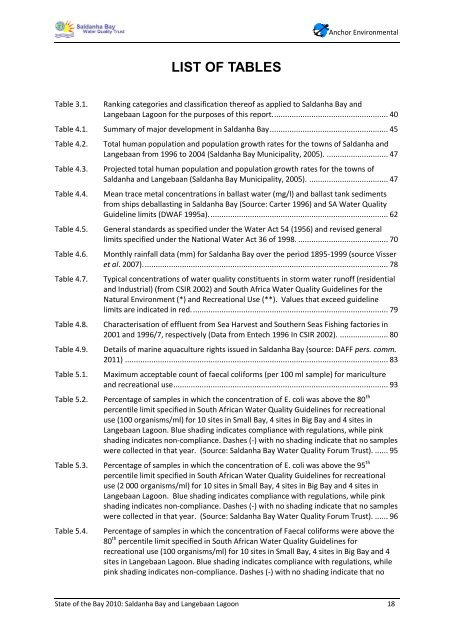State of the Bay Report 2010-Final - Anchor Environmental
State of the Bay Report 2010-Final - Anchor Environmental
State of the Bay Report 2010-Final - Anchor Environmental
Create successful ePaper yourself
Turn your PDF publications into a flip-book with our unique Google optimized e-Paper software.
LIST OF TABLES<br />
<strong>Anchor</strong> <strong>Environmental</strong><br />
Table 3.1. Ranking categories and classification <strong>the</strong>re<strong>of</strong> as applied to Saldanha <strong>Bay</strong> and<br />
Langebaan Lagoon for <strong>the</strong> purposes <strong>of</strong> this report. .................................................... 40<br />
Table 4.1. Summary <strong>of</strong> major development in Saldanha <strong>Bay</strong> ...................................................... 45<br />
Table 4.2. Total human population and population growth rates for <strong>the</strong> towns <strong>of</strong> Saldanha and<br />
Langebaan from 1996 to 2004 (Saldanha <strong>Bay</strong> Municipality, 2005). ............................ 47<br />
Table 4.3. Projected total human population and population growth rates for <strong>the</strong> towns <strong>of</strong><br />
Saldanha and Langebaan (Saldanha <strong>Bay</strong> Municipality, 2005). .................................... 47<br />
Table 4.4. Mean trace metal concentrations in ballast water (mg/l) and ballast tank sediments<br />
from ships deballasting in Saldanha <strong>Bay</strong> (Source: Carter 1996) and SA Water Quality<br />
Guideline limits (DWAF 1995a). ................................................................................. 62<br />
Table 4.5. General standards as specified under <strong>the</strong> Water Act 54 (1956) and revised general<br />
limits specified under <strong>the</strong> National Water Act 36 <strong>of</strong> 1998. ......................................... 70<br />
Table 4.6. Monthly rainfall data (mm) for Saldanha <strong>Bay</strong> over <strong>the</strong> period 1895-1999 (source Visser<br />
et al. 2007). ............................................................................................................... 78<br />
Table 4.7. Typical concentrations <strong>of</strong> water quality constituents in storm water run<strong>of</strong>f (residential<br />
and Industrial) (from CSIR 2002) and South Africa Water Quality Guidelines for <strong>the</strong><br />
Natural Environment (*) and Recreational Use (**). Values that exceed guideline<br />
limits are indicated in red. ......................................................................................... 79<br />
Table 4.8. Characterisation <strong>of</strong> effluent from Sea Harvest and Sou<strong>the</strong>rn Seas Fishing factories in<br />
2001 and 1996/7, respectively (Data from Entech 1996 In CSIR 2002). ...................... 80<br />
Table 4.9. Details <strong>of</strong> marine aquaculture rights issued in Saldanha <strong>Bay</strong> (source: DAFF pers. comm.<br />
2011) ........................................................................................................................ 83<br />
Table 5.1. Maximum acceptable count <strong>of</strong> faecal coliforms (per 100 ml sample) for mariculture<br />
and recreational use .................................................................................................. 93<br />
Table 5.2. Percentage <strong>of</strong> samples in which <strong>the</strong> concentration <strong>of</strong> E. coli was above <strong>the</strong> 80 th<br />
percentile limit specified in South African Water Quality Guidelines for recreational<br />
use (100 organisms/ml) for 10 sites in Small <strong>Bay</strong>, 4 sites in Big <strong>Bay</strong> and 4 sites in<br />
Langebaan Lagoon. Blue shading indicates compliance with regulations, while pink<br />
shading indicates non-compliance. Dashes (-) with no shading indicate that no samples<br />
were collected in that year. (Source: Saldanha <strong>Bay</strong> Water Quality Forum Trust). ...... 95<br />
Table 5.3. Percentage <strong>of</strong> samples in which <strong>the</strong> concentration <strong>of</strong> E. coli was above <strong>the</strong> 95 th<br />
percentile limit specified in South African Water Quality Guidelines for recreational<br />
use (2 000 organisms/ml) for 10 sites in Small <strong>Bay</strong>, 4 sites in Big <strong>Bay</strong> and 4 sites in<br />
Langebaan Lagoon. Blue shading indicates compliance with regulations, while pink<br />
shading indicates non-compliance. Dashes (-) with no shading indicate that no samples<br />
were collected in that year. (Source: Saldanha <strong>Bay</strong> Water Quality Forum Trust). ...... 96<br />
Table 5.4. Percentage <strong>of</strong> samples in which <strong>the</strong> concentration <strong>of</strong> Faecal coliforms were above <strong>the</strong><br />
80 th percentile limit specified in South African Water Quality Guidelines for<br />
recreational use (100 organisms/ml) for 10 sites in Small <strong>Bay</strong>, 4 sites in Big <strong>Bay</strong> and 4<br />
sites in Langebaan Lagoon. Blue shading indicates compliance with regulations, while<br />
pink shading indicates non-compliance. Dashes (-) with no shading indicate that no<br />
<strong>State</strong> <strong>of</strong> <strong>the</strong> <strong>Bay</strong> <strong>2010</strong>: Saldanha <strong>Bay</strong> and Langebaan Lagoon 18

















